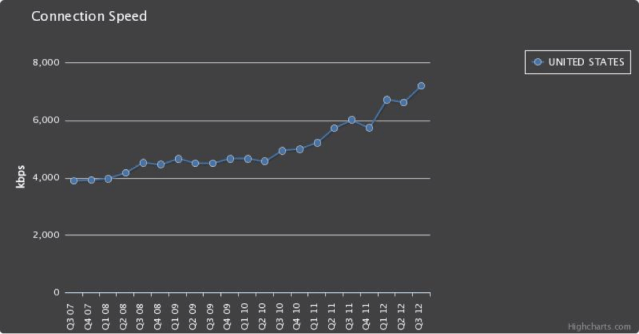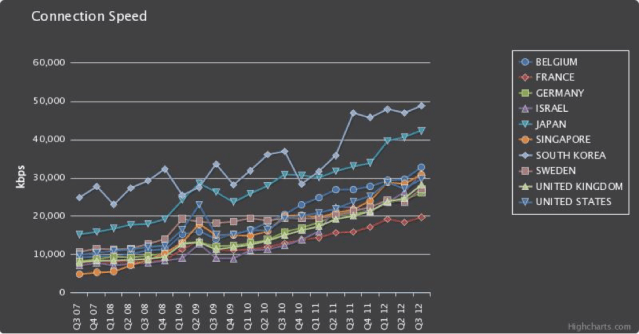Editor's note: Richard Bennett is a Senior Fellow with the Information Technology and Innovation Foundation and co-author of ITIF's 2013 report, "The Whole Picture: Where America's Broadband Networks Really Stand." Follow him on Twitter @iPolicy.
We've all heard the story: America's broadband networks are second-rate. We pay exorbitant prices for shoddy service because broadband providers print money and hold innovation in a death grip. While America languishes, our competitors in Europe and Asia are racing ahead to a user-generated content utopia. The only way forward is a government takeover, or, failing that, a massive dose of regulation.
So go a number of recent treatises such as Susan Crawford's "Captive Audience"; works by like-minded Internet aficionados Tim Wu, Lawrence Lessig, and Yochai Benkler; reports by public interest advocacy groups Free Press, Public Knowledge, and the Open Technology Institute; as well as numerous tech bloggers.
The only problem with this story is that it's almost completely untrue.
Granted, as recently as the late aughts, the story was plausible: In those dark days, our rankings in terms of both broadband subscription growth and speeds were falling. Increased demand for data capacity and a technology lull combined to push our average Internet connection speed down to 22nd in the world at the end of 2009, according to Akamai's measurement of "Average Connection Speed." Since then, the speeds of such shared connections have nearly doubled from 3.9Mbps to 7.2 Mbps, raising the U.S. to eighth place.

U.S. Average Connection Speed per Akamai
Akamai's Average Connection Speed measures individual TCP streams over IP addresses that are often shared — and doesn't sum simultaneous streams — so it's more a measure of usage than of network capacity, however. To see the capacity of the underlying broadband network, it's best to look at Akamai's "Average Peak Connection Speed" metric.
The distinction between these two metrics flummoxed Ars Technica's Cyrus Farivar, who maintains that the shared-connection measurement is the more meaningful indication of "user experience." Farivar is clearly wrong about that, and Akamai's "Average Peak Connection Speed" is the better indicator of network improvement.
The Average Peak measurement shows performance in the U.S. tripling over the past five years, up to 31.5Mbps in Q4 2012. We don't know where the U.S. ranked on this scale before mid-2010, but it's currently 13th. The tripling of network capacity combined with a doubling of "shared speed" says that networks are getting faster, as the U.S. is simultaneously using them more heavily

Average Peak Connection Speed per Akamai
America's broadband speeds are improving for two reasons: first, broadband providers have installed newer technologies, such as Verizon FiOS, DOCSIS 3 cable modems, and AT&T U-verse that are four or more times faster than the technologies they replaced; and second, users have begun to demonstrate a preference for higher-speed broadband by opting into higher-speed upgrades. Some upgrades are costly and others are not; Comcast recently doubled the speeds of most of their Bay Area broadband plans for free.
While our networks are improving, we're retaining low prices for entry-level broadband plans first noticed by the Berkman Center's "Next Generation Connectivity" report: the U.S. is currently second in the price of broadband for entry-level users. The nation is also third in network-based competition, second in the fiber-optic installation rate, first in the adoption of next-generation LTE, ahead of Europe in broadband adoption, and doing quite well in Internet-based services.
While U.S. cable TV companies still lead telcos in new broadband subscriptions, fiber-based telco broadband is gaining subscribers at a faster rate than cable. U.S. broadband providers are profitable, but much less so than Europe's or Korea's, where applications like YouTube must pay ISPs for access to residential customers. Significantly, we've gained ground on competitors despite an enormous disadvantage stemming from America's very low urban population densities, which make U.S. broadband networks much more expensive to build and maintain than those in most nations.
Amazingly, the European Commission's top telecom regulator, Vice President Neelie Kroes, tells a story much like the tales of woe we hear from American broadband critics, but with the roles reversed: Kroes laments Europe's declining standing relative to the U. S., where "high-speed networks now pass more than 80 percent of homes; a figure that quadrupled in three years." To facilitate private investment in networks, Europe has developed a "Ten Step Plan" for a single, cross-border market for broadband that mimics our interstate, facilities-based broadband market.
But these facts are glossed over by the critics of U.S. broadband policy in large part because they directly contradict their neo-populist narrative of rapacious, profit-hungry broadband monopolists gouging consumers. The long tradition of American populism distrusts private provision of "essential" services and refuses to believe that competition can ever be brought to bear on infrastructure markets. Crawford in particular relies too heavily on a strained analogy with electricity, a genuine natural monopoly that is as different from the competing information networks we have in the broadband space as any network can possibly be: Can you get electric service over the air?
Critics also come up short on research, generally refusing to consult updated primary sources in favor of blog posts and news articles from inside the echo chamber that simply reinforce the traditional narrative. "Confirmation bias" is rampant in broadband criticism.
Broadband advocates would do better to focus their efforts on real problems, such as our dismally low level of interest in the Internet, the primary reason non-subscribers give for refusing to go online. Ideally, these efforts would be combined with initiatives to increase computer ownership among the poor — the second reason so few Americans use the Internet. The world's high-subscription nations, such as Korea and Singapore, aren't the price leaders for entry-level Internet services as we are, but they've led successful outreach efforts to spread computer ownership, digital literacy, and Internet awareness across their entire populations.
Getting all of America online is a goal that all Americans can support regardless of party creed or ideological doctrine. If we can make as much progress with online participation as we've made with speed, Europe will have a second Internet crisis on its hands.
No hay comentarios:
Publicar un comentario